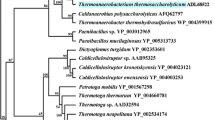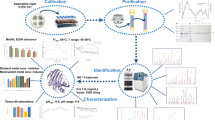Abstract
A xylanase gene, xynA4-2, was obtained from the genome sequence of thermoacidophilic Alicyclobacillus sp. A4 and expressed in Escherichia coli BL21 (DE3). xynA4-2 encodes a mature protein of 411 residues with a calculated molecular weight of 46.8 kDa. Based on the amino acid sequence similarities (highest identity of 61%), the enzyme was confined into glycoside hydrolase family 10. The purified recombinant XynA4-2 exhibited maximum activity at pH 6.2 and 55°C. The enzyme was stable over a broad pH range, retaining more than 90% of the original activity at pH 5.8–12.0, 37°C for 1 h. The substrate specificity of XynA4-2 was relatively narrow, exhibiting 100, 93, and 35% of the relative activity towards birchwood xylan, oat spelt xylan, and wheat arabinoxylan, respectively. Supplementation of XynA4-2 to mash caused the reduction of mash filtration rate (5.6%) and viscosity (4.0%). When combined with the commercial glucanase from Sunson, higher reduction was detected in the filtration rate (12.0%) and viscosity (17.2%). These favorable properties make XynA4-2 a good candidate in the brewing industry.



Similar content being viewed by others
References
Albuquerque L, Rainey FA, Chung AP, Sunna A, Nobre MF, Grote R, Antranikian G, da Costa MS (2000) Alicyclobacillus hesperidum sp nov. and a related genomic species from solfataric soils of Sao Miguel in the Azores. Int J Syst Evol Microbiol 50:451–457
Bai Y, Wang J, Zhang Z, Yang P, Shi P, Luo H, Meng K, Huang H, Yao B (2010a) A new xylanase from thermoacidophilic Alicyclobacillus sp. A4 with broad-range pH activity and pH stability. J Ind Microbiol Biotechnol 37:187–194
Bai Y, Wang J, Zhang Z, Shi P, Luo H, Huang H, Luo C, Yao B (2010b) A novel family 9 β-1,3(4)-glucanase from thermoacidophilic Alicyclobacillus sp. A4 with potential application in the brewing industry. Appl Microbiol Biotechnol. doi: 10.1007/s00253-010-2452-3
Bai Y, Wang J, Zhang Z, Shi P, Luo H, Huang H, Luo C, Yao B (2010c) An extremely acidic β-glucanase, CelA4, from thermoacidophilic Alicyclobacillus sp. A4 with high protease resistance and potential as a pig feed additive. J Agric Food Chem. doi: 10.1021/jf9035595
Biely P (1985) Microbial xylanolytic systems. Trends Biotechnol 3:286–290
Bradford MM (1976) A rapid and sensitive method for the quantitation of microgram quantities of protein utilizing the principle of protein-dye binding. Anal Biochem 72:248–254
Celestino KR, Cunha RB, Felix CR (2006) Characterization of a β-glucanase produced by Rhizopus microsporus var. microsporus, and its potential for application in the brewing industry. BMC Biochem 7:23
Coote N, Kirsop B (1976) A haze consisting largely of pentosan. J Inst Brew 82:34
Debyser W, Derdelinckx G, Delcour J (1997) Arabinoxylan solubilization and inhibition of the barley malt xylanolytic system by wheat during mashing with wheat wholemeal adjunct: evidence for a new class of enzyme inhibitors in wheat. Am Soc Brew Chem USA 55:153–156
Eckert K, Schneider E (2003) A thermoacidophilic endoglucanase (CelB) from Alicyclobacillus acidocaldarius displays high sequence similarity to arabinofuranosidases belonging to family 51 of glycoside hydrolases. Eur J Biochem 270:3593–3602
Eckert K, Zielinski F, Lo Leggio L, Schneider E (2002) Gene cloning, sequencing, and characterization of a family 9 endoglucanase (CelA) with an unusual pattern of activity from the thermoacidophile Alicyclobacillus acidocaldarius ATCC27009. Appl Microbiol Biotechnol 60:428–436
Fincher G (1989) Molecular and cellular biology associated with endosperm mobilization in germinating cereal grains. Ann Rev Plant Biol 40:305–346
Gilkes NR, Henrissat B, Kilburn DG, RC Miller Jr, Warren RA (1991) Domains in microbial β-1, 4-glycanases: sequence conservation, function, and enzyme families. Microbiol Rev 55:303–315
Goto K, Tanimoto Y, Tamura T, Mochida K, Arai D, Asahara M, Suzuki M, Tanaka H, Inagaki K (2002) Identification of thermoacidophilic bacteria and a new Alicyclobacillus genomic species isolated from acidic environments in Japan. Extremophiles 6:333–340
Groenewald WH, Gouws PA, Witthuhn RC (2009) Isolation, identification and typification of Alicyclobacillus acidoterrestris and Alicyclobacillus acidocaldarius strains from orchard soil and the fruit processing environment in South Africa. Food Microbiol 26:71–76
Henrissat B, Bairoch A (1996) Updating the sequence-based classification of glycosyl hydrolases. Biochem J 316:695–696
Laemmli UK (1970) Cleavage of structural proteins during the assembly of the head of bacteriophage T4. Nature 227:680–685
Li N, Meng K, Wang Y, Shi P, Luo H, Bai Y, Yang P, Yao B (2008a) Cloning, expression, and characterization of a new xylanase with broad temperature adaptability from Streptomyces sp. S9. Appl Microbiol Biotechnol 80:231–240
Li N, Shi P, Yang P, Wang Y, Luo H, Bai Y, Zhou Z, Yao B (2008b) A xylanase with high pH stability from Streptomyces sp. S27 and its carbohydrate-binding module with/without linker-region-truncated versions. Appl Microbiol Biotechnol 83:99–107
McCleary BV, Shameer I, Glennie-Holmes M, Willis AW, Scott TK (1988) Measurement of (1→3),(1→4)-β-d-glucan. Methods in enzymology. Academic Press, New York, pp 545–551
Miller GL (1959) Use of dinitrosalicylic acid reagent for determination of reducing sugar. Analyt Chem 31:426–428
Morana A, Esposito A, Maurelli L, Ruggiero G, Ionata E, Rossi M, La Cara F (2008) A novel thermoacidophilic cellulase from Alicyclobacillus acidocaldarius. Protein Pept Lett 15:1017–1021
Prade RA (1995) Xylanases: from biology to biotechnology. Biotech Genet Eng Rev 13:100–131
Qiu Z, Shi P, Luo H, Bai Y, Yuan T, Yang P, Liu S, Yao B (2010) A xylanase with broad pH and temperature adaptability from Streptomyces megasporus DSM 41476, and its potential application in brewing industry. Enzyme Microb Tech. doi: 10.1016/j.enzmictec.2010.02.003
Schwarz P, Han J (1995) Arabinoxylan content of commercial beers. Am Soc Brew Chem USA 53:157–159
Shulami S, Gat O, Sonenshein A, Shoham Y (1999) The glucuronic acid utilization gene cluster from Bacillus stearothermophilus T-6. J Bacteriol 181:3695–3704
Tabernero C, Sanchez-Torres J, Perez P, Santamaria RI (1995) Cloning and DNA sequencing of xyaA, a gene encoding an endo-β-1, 4-xylanase from an alkalophilic Bacillus strain (N137). Appl Environ Microbiol 61:2420–2424
van de Werken HJ, Verhaart MR, VanFossen AL, Willquist K, Lewis DL, Nichols JD, Goorissen HP, Mongodin EF, Nelson KE, van Niel EW, Stams AJ, Ward DE, de Vos WM, van der Oost J, Kelly RM, Kengen SW (2008) Hydrogenomics of the extremely thermophilic bacterium Caldicellulosiruptor saccharolyticus. Appl Environ Microbiol 74:6720–6729
Viëtor RJ, Voragen AGJ, Angelino SAGF, Pilnik W (1991) Non-starch polysaccharides in barley and malt: a mass balance of flour fractionation. J Cereal Sci 14:73–83
Viëtor R, Angelino S, Voragen A (1993) Composition of non-starch polysaccharides in wort and spent grains from brewing trials with malt from a good malting quality barley and a feed barley. J Inst Brew 99:243–248
Vlasenko EY, Ryan AI, Shoemaker CF, Shoemaker SP (1998) The use of capillary viscometry, reducing end-group analysis, and exclusion chromatography combined with multi-angle laser light scattering to characterize endo-1,4-β-d-glucanases on carboxymethylcellulose: a comparative evaluation of the three methods. Enzyme Microb Technol 23:350–359
Voragen A, Schols H, Marijs J, Rombouts F, Angelino S (1987) Non-starch polysaccharides from barley: structural features and breakdown during malting. J Inst Brew 93:202–208
Wisotzkey JD, P Jurtshuk Jr, Fox GE, Deinhard G, Poralla K (1992) Comparative sequence analyses on the 16S rRNA (rDNA) of Bacillus acidocaldarius, Bacillus acidoterrestris, and Bacillus cycloheptanicus and proposal for creation of a new genus, Alicyclobacillus gen nov. Int J Syst Bacteriol 42:263–269
Acknowledgments
This work was supported by the National High Technology Research and Development Program of China (863 program, grant 2007AA100601) and Agricultural Science and Technology Conversion Funds (grant 2008GB23260388) and the Earmarked Fund for Modern Agro-industry Technology Research System (NYCYTX-42-G2-05).
Author information
Authors and Affiliations
Corresponding author
Rights and permissions
About this article
Cite this article
Wang, J., Bai, Y., Shi, P. et al. A novel xylanase, XynA4-2, from thermoacidophilic Alicyclobacillus sp. A4 with potential applications in the brewing industry. World J Microbiol Biotechnol 27, 207–213 (2011). https://doi.org/10.1007/s11274-010-0445-0
Received:
Accepted:
Published:
Issue Date:
DOI: https://doi.org/10.1007/s11274-010-0445-0




